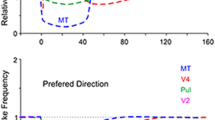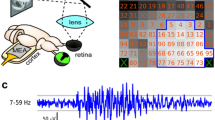Abstract
The visual system of the cat is considered to be organized in both a serial and parallel manner. Studies of visual onset latencies generally suggest that parallel processing occurs throughout the dorsal stream. These studies are at odds with the proposed hierarchies of visual areas based on termination patterns of cortico–cortical projections. In previous studies, a variety of stimuli have been used to compute latencies, and this is problematic as latencies are known to depend on stimulus parameters. This could explain the discrepancy between latency and neuroanatomical based studies. Therefore, the first aim of the present study was to determine whether latencies increased along the hierarchy of visual areas when the same stimuli are used. In addition, the effect of stimulus complexity was assessed. Visual onset latencies were calculated for area 17, PMLS, AMLS, and AEV neurons. Latencies were also computed from neurons in the lateral posterior (LP)-pulvinar complex given the importance of this extrageniculate complex in cortical intercommunication. Latency distributions from all regions overlapped substantially, and no significant difference was present, regardless of the type of stimulus used. The onset latencies in the LP–pulvinar complex were comparable to those seen in cortical areas. The data suggest that the initial processing of information in the visual system is parallel, despite the presence of a neuroanatomical hierarchy. Simultaneous response onsets among cortical areas and the LP-pulvinar suggest that the latter is more than a simple relay station for information headed to cortex. The data are consistent with proposals of the LP-pulvinar as a center for the integration and distribution of information from/to multiple cortical areas.





Similar content being viewed by others
References
Abramson BP, Chalupa LM (1985) The laminar distribution of cortical connections with the tecto- and cortico-recipient zones in the cat’s lateral posterior nucleus. Neuroscience 15:81–95
Bair W, Movshon JA (2004) Adaptive temporal integration of motion in direction-selective neurons in macaque visual cortex. J Neurosci 24:7305–7323
Berson DM, Graybiel AM (1983) Organization of the striate-recipient zone of the cats lateralis posterior-pulvinar complex and its relations with the geniculostriate system. Neuroscience 9:337–372
Best J, Reuss S, Dinse HR (1986) Lamina-specific differences of visual latencies following photic stimulation in the cat striate cortex. Brain Res 385:356–360
Bullier J (2001) Integrated model of visual processing. Brain Res Brain Res Rev 36:96–107
Bullier J (2004) Communications between cortical areas of the visual system. In: The visual neurosciences, vol 2. Bradford Book, Cambridge pp 522–540
Casanova C, Merabet L, Desautels A, Minville K (2001) Higher-order motion processing in the pulvinar. In: Casanova C, Ptito M (eds) Progress in brain research, vol 134, pp 71–82
Creutzfeldt O, Ito M (1968) Functional synaptic organization of primary visual cortex neurones in the cat. Exp Brain Res 6:324–352
Dinse HR, Kruger K (1994) The timing of processing along the visual pathway in the cat. Neuroreport 5:893–897
Dumbrava D, Faubert J, Casanova C (2001) Global motion integration in the cat’s lateral posterior-pulvinar complex. Eur J Neurosci 13:2218–2226
Ellaway PH (1978) Cumulative sum technique and its application to the analysis of peristimulus time histograms. Electroencephalogr Clin Neurophysiol 45:302–304
Eordegh G, Nagy A, Berenyi A, Benedek G (2005) Processing of spatial visual information along the pathway between the suprageniculate nucleus and the anterior ectosylvian cortex. Brain Res Bull 67:281–289
Eschweiler GW, Rauschecker JP (1993) Temporal integration in visual cortex of cats with surgically induced strabismus. Eur J Neurosci 5:1501–1509
Felleman DJ, Van Essen DC (1991) Distributed hierarchical processing in the primate cerebral cortex. Cereb Cortex 1:1–47
Galuske RA, Schmidt KE, Goebel R, Lomber SG, Payne BR (2002) The role of feedback in shaping neural representations in cat visual cortex. Proc Natl Acad Sci U S A 99:17083–17088
Graybiel AM, Berson DM (1980) Histochemical identification and afferent connections of subdivisions in the lateralis posterior-pulvinar complex and related thalamic nuclei in the cat. Neuroscience 5:1175–1238
Guido W, Spear PD, Tong L (1990) Functional compensation in the lateral suprasylvian visual area following bilateral visual cortex damage in kittens. Exp Brain Res 83:219–224
Guido W, Spear PD, Tong L (1992) How complete is physiological compensation in extrastriate cortex after visual cortex damage in kittens? Exp Brain Res 91:455–466
Hilgetag CC, O’Neill MA, Young MP (2000) Hierarchical organization of macaque and cat cortical sensory systems explored with a novel network processor. Philos Trans R Soc Lond B Biol Sci 355:71–89
Hupe JM, James AC, Girard P, Lomber SG, Payne BR, Bullier J (2001) Feedback connections act on the early part of the responses in monkey visual cortex. J Neurophysiol 85: 134–145
Huppé-Gourgue F, Bickford ME, Boire D, Ptito M, Casanova C (2006) Distribution, morphology and synaptic targets of corticothalamic terminals in the cat lateral posterior-pulvinar complex that originates from the posteromedial lateral suprasylvian cortex. J Comp Neurol (in press)
Ikeda H, Wright MJ (1975) Retinotopic distribution. Visual latency and orientation tuning of ‘sustained’ and ‘transient’ cortical neurones in area 17 of the cat. Exp Brain Res 22:385–398
Kalil RE, Tong LL, Spear PD (1991) Thalamic projections to the lateral suprasylvian visual area in cats with neonatal or adult visual cortex damage. J Comp Neurol 314:512–525
Katsuyama N, Tsumoto T, Sato H, Fukuda M, Hata Y (1996) Lateral suprasylvian visual cortex is activated earlier than or synchronously with primary visual cortex in the cat. Neurosci Res 24:431–435
Lamme VA, Roelfsema PR (2000) The distinct modes of vision offered by feedforward and recurrent processing. Trends Neurosci 23:571–579
Lennie P (1980) Parallel visual pathways: a review. Vision Res 20:561–594
Lennie P (1981) The physiological basis of variations in visual latency. Vision Res 21:815–824
Levick WR (1973) Variation in the response latency of cat retinal ganglion cells. Vision Res 13:837–853
Maunsell JH, van Essen DC (1983) The connections of the middle temporal visual area (MT) and their relationship to a cortical hierarchy in the macaque monkey. J Neurosci 3:2563–2586
Merabet L, Desautels A, Minville K, Casanova C (1998) Motion integration in a thalamic visual nucleus. Nature 396:265–268
Miller R (1996) Cortico-thalamic interplay and the security of operation of neural assemblies and temporal chains in the cerebral cortex. Biol Cybern 75:263–275
Mishkin M, Ungerleider LG, Macko KA (1983) Object vision and spatial vision: two cortical pathways. Trends Neurosci 6:263–275
Movshon JA, Adelson EH, Gizzi MS, Newsome WT (1986) The analysis of moving visual patterns. In: Chagas C, Gattas R, Gross C (eds) Pattern recognition mechanisms. Springer Verlag, New york, pp 148–164
Mumford D (1992) On the computational architecture of the neocortex. II. The role of cortico–cortical loops. Biol Cybern 66: 241–251
Norita M, Kase M, Hoshino K, Meguro R, Funaki S, Hirano S, McHaffie JG (1996) Extrinsic and intrinsic connections of the cat’s lateral suprasylvian visual area. Prog Brain Res 112: 231–250
Norita M, Mucke L, Benedek G, Albowitz B, Katoh Y, Creutzfeldt OD (1986) Connections of the anterior ectosylvian visual area (AEV). Exp Brain Res 62:225–240
Nowak LG, Munk MH, Girard P, Bullier J (1995) Visual latencies in areas V1 and V2 of the macaque monkey. Vis Neurosci 12:371–384
Ouellette BG, Lindsay B, Casanova C (2004a) Visual response latencies vary for different stimuli and across visual areas in cats. Society for Neuroscience Abstracts: 410.417
Ouellette BG, Minville K, Boire D, Ptito M, Casanova C (2002) Simple and complex motion selectivity in PMLS cortex following early primary visual cortex lesions in the cat. Society for Neuroscience Abstracts: 657.655
Ouellette BG, Minville K, Faubert J, Casanova C (2004b) Simple and complex visual motion response properties in the anterior medial bank of the lateral suprasylvian cortex. Neuroscience 123:231–245
Pascual-Leone A, Walsh V (2001) Fast backprojections from the motion to the primary visual area necessary for visual awareness. Science 292:510–512
Payne BR, Lomber SG (1998) Neuroplasticity in the cat’s visual system. Origin, termination, expansion, and increased coupling of the retino-geniculo-middle suprasylvian visual pathway following early ablations of areas 17 and 18. Exp Brain Res 121:334–349
Petroni F, Panzeri S, Hilgetag CC, Kotter R, Young MP (2001) Simultaneity of responses in a hierarchical visual network. Neuroreport 12:2753–2759
Raiguel SE, Lagae L, Gulyas B, Orban GA (1989) Response latencies of visual cells in macaque areas V1, V2 and V5. Brain Res 493:155–159
Raiguel SE, Xiao DK, Marcar VL, Orban GA (1999) Response latency of macaque area MT/V5 neurons and its relationship to stimulus parameters. J Neurophysiol 82:1944–1956
Robinson DL, Rugg MD (1988) Latencies of visually responsive neurons in various regions of the rhesus monkey brain and their relation to human visual responses. Biol Psychol 26:111–116
Rockland KS, Pandya DN (1979) Laminar origins and terminations of cortical connections of the occipital lobe in the rhesus monkey. Brain Res 179:3–20
Scannell JW, Blakemore C, Young MP (1995) Analysis of connectivity in the cat cerebral cortex. J Neurosci 15:1463–1483
Scannell JW, Burns GA, Hilgetag CC, O’Neil MA, Young MP (1999) The connectional organization of the cortico-thalamic system of the cat. Cereb Cortex 9:277–299
Scannell JW, Sengpiel F, Tovee MJ, Benson PJ, Blakemore C, Young MP (1996) Visual motion processing in the anterior ectosylvian sulcus of the cat. J Neurophysiol 76:895–907
Scannell JW, Young MP (1993) The connectional organization of neural systems in the cat cerebral cortex. Curr Biol 3:191–200
Schmolesky MT, Wang Y, Hanes DP, Thompson KG, Leutgeb S, Schall JD, Leventhal AG (1998) Signal timing across the macaque visual system. J Neurophysiol 79:3272–3278
Schroeder CE, Mehta AD, Givre SJ (1998) A spatiotemporal profile of visual system activation revealed by current source density analysis in the awake macaque. Cereb Cortex 8:575–592
Sherman SM, Guillery RW (1998) On the actions that one nerve cell can have on another: distinguishing “drivers” from “modulators”. Proc Natl Acad Sci USA 95:7121–7126
Smith MA, Majaj NJ, Movshon JA (2005) Dynamics of motion signaling by neurons in macaque area MT. Nat Neurosci 8:220–228
Stone J, Dreher B, Leventhal A (1979) Hierarchical and parallel mechanisms in the organization of visual cortex. Brain Res 180:345–394
Symonds LL, Rosenquist AC (1984) Laminar origins of visual corticocortical connections in the cat. J Comp Neurol 229:39–47
Tong L, Kalil RE, Spear PD (1984) Critical periods for functional and anatomical compensation in lateral suprasylvian visual area following removal of visual cortex in cats. J Neurophysiol 52:941–960
Updyke BV (1981) Projections from visual areas of the middle suprasylvian sulcus onto the lateral posterior complex and adjacent thalamic nuclei in cat. J Comp Neurol 201:477–506
Vidnyanszky Z, Borostyankoi Z, Gorcs TJ, Hamori J (1996) Light and electron microscopic analysis of synaptic input from cortical area 17 to the lateral posterior nucleus in cats. Exp Brain Res 109:63–70
Villeneuve MY, Ptito M, Casanova C (2006) Global motion integration in the postero-medial part of the lateral suprasylvian cortex in the cat. Exp brain Res (in press)
Vogels R, Orban GA (1990) How well do response changes of striate neurons signal differences in orientation: a study in the discriminating monkey. J Neurosci 10:3543–3558
Vogels R, Orban GA (1994) Activity of inferior temporal neurons during orientation discrimination with successively presented gratings. J Neurophysiol 71:1428–1451
Zabouri N, Ptito M, Casanova C (2003) Complex motion sensitivity of neurons in the visual part of the anterior ectosylvian cortex. Society for Neuroscience Abstracts: 179.174
Acknowledgments
This work was supported by a CIHR grant to C.C. and part of C.C.’s salary was provided by FRSQ (chercheur National). B.G.O. was supported by FRSQ and NSERC scholarships. We thank those who generously shared their data so as to allow the calculation of response onset latencies. The authors also wish to thank Annie-Hélène Samson and Barbara Lindsay for their help in calculating the latencies.
Author information
Authors and Affiliations
Corresponding author
Rights and permissions
About this article
Cite this article
Ouellette, B.G., Casanova, C. Overlapping visual response latency distributions in visual cortices and LP-pulvinar complex of the cat. Exp Brain Res 175, 332–341 (2006). https://doi.org/10.1007/s00221-006-0555-y
Received:
Accepted:
Published:
Issue Date:
DOI: https://doi.org/10.1007/s00221-006-0555-y




